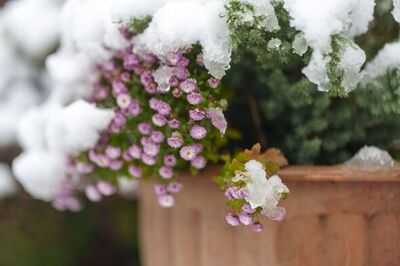
As winter rapidly approaches, gardeners are being urged to protect their delicate plants from the impending frost. While it's often the more vulnerable outdoor plants that come to mind first when considering protection, one expert has revealed that even the toughest evergreen plants could suffer if not properly cared for.
Jonathan Webster, curator at RHS Garden Rosemoor in Devon, explained: "If they haven't had time to get used to that cold and shut down, it can cause them more damage. Even hardy plants could have damage to the newer foliage on the tips of the plants. We live in a frost pocket here, as Rosemoor sits in a valley and I remember one year when we had a really warm summer and then a really cold spell in early December.
"One week it was about 12 degrees, and then the next it dropped to minus nine and we had lots of plants you would consider hardy-ish - but because they hadn't hardened off for winter and hadn't had that slower transition from warm to cold, we lost some. We had 10-year-old pittosporums (evergreen shrubs), which come from New Zealand, and they literally all just died."
How to tell if it's really deadIf your plants have suffered frost damage, Webster advises patience while they recover.
He explained: "If it's a shrub, if it's evergreen, technically they do reshoot from older wood, so wait until spring for signs of life."
One way to check if the plant has survived is by examining the stems. Performing a small scratch test on the stem should reveal bright green beneath the surface, but if this appears pale then the plant has perished.
If your plant isn't dead but has sustained cold damage, some gardeners might choose to trim away the damaged sections, but Webster suggested waiting until spring as this outer layer could be shielding what lies beneath.
He explained: "Leave it till you see the plant come to life again with new growth in March or early April."
How to protect your plantsThe initial step to winter-proofing your garden involves bringing delicate plants indoors.
This can mean lifting perennial plants like dahlias once the cold has struck them.
Lifting the plant means removing them from the soil, shaking off as much earth as possible, cutting back the stems, and hanging them upside down.
You can also position tender plants close to a wall, which can offer additional warmth, or beneath shelter to shield them from wind.
Maintaining the top growth on plants leading up to winter can offer some defence, and protective mulch can also prove highly beneficial. Should a cold spell be predicted for your region, you can carry out some final-minute protective measures by throwing horticultural fleece across your plants.
Webster continued: "If you've planted something new, evergreens can suffer from winter cold winds, which take the moisture out of the leaves. You could put a little shelter around them, some canes and some fleece, just to keep the wind off and create a little microclimate."
You may also like

The rare reason why acorns are everywhere this autumn

Strictly Come Dancing LIVE: Celebrities light up the dance floor as Stefan returns

Bihar polls: Congress releases second list of candidates amid turmoil

'I waited over 30 years to be crowned UK pageant queen, I'm chuffed to bits'

From 'Orange Lies Matter' to 'Make Fascists Afraid Again': 10 placards that stole the show at 'No Kings' protest







